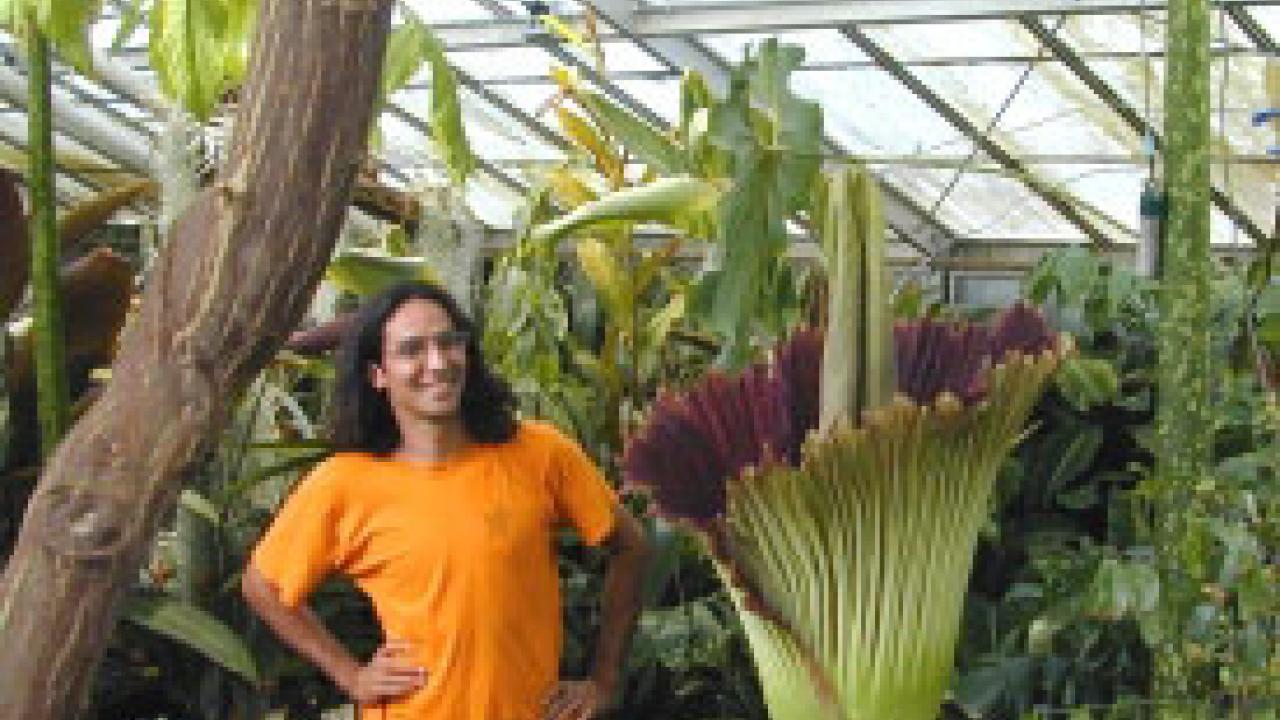"Ted the Titan," a specimen of titan arum or the "corpse flower," is set to bloom as soon as this Friday, May 4, at the UC Davis Botanical Conservatory. Ted's bloom will be more than four feet tall and look and smell like rotting meat.
The conservatory will be open to the public from 9 a.m. to 5 p.m. through this weekend, Saturday and Sunday, May 5 and 6. On the day the bloom opens fully, the greenhouse will remain open until 10 p.m. so visitors can experience the flower at its best. For updates, check http://greenhouse.ucdavis.edu/conservatory/index.html. The conservatory is located just north of Storer Hall on the UC Davis campus.
This is the third time that Ted has felt the urge to bloom. In 2003, it was the first titan arum to bloom at UC Davis. Tabatha, another titan arum, flowered in 2004. In 2005, Ted went on the road to the San Francisco Conservatory of Flowers.
"I think we understand the biology pretty well now," said Ernesto Sandoval, curator of the conservatory, who has been tending Ted and the other corpse flowers (scientific name Amorphophallus titanum) in the greenhouse. "We're learning a bit more about how to propagate them and hope to analyze the odors in greater detail."
Sandoval has managed to propagate the plants from leaf cuttings. A previous attempt to pollinate one of the other titan arum plants in the conservatory was unsuccessful, so Ted will go unpollinated this year, which will prolong the bloom.
Titan arums are native to the Indonesian island of Sumatra. They attract pollinating insects by imitating a large chunk of rotting meat. As the flower opens, it exposes a long, green conical structure or "spadix" surrounded by a red, petal-like structure. The spadix generates heat internally to release a mix of sulfur-containing compounds that smell like rotting eggs or flesh. The bloom will last for two to five days before collapsing.
Eric Winegar, a UC Davis alumnus and professional air quality analyst, is planning to collect gases from the plant for testing, and Sandoval is hoping to set up temperature monitoring equipment as well.
The plant spends most of its life as an underground stem, or corm. Once a year, it puts out a single large green leaf, which it uses to gather energy from sunlight, stored as carbohydrates in the corm.
The bigger the leaf, the bigger the bloom it can produce. The leaf Ted produced earlier this year was its biggest yet, said Tim Metcalf, director of the conservatory.
The Botanical Conservatory serves the university and public communities as an educational facility, research resource and genetic-diversity preserve. The only such facility in the Central Valley, it houses more than 3,000 plant species in more than 150 families that are mostly from the tropics, sub-tropics and desert regions.
Media Resources
Andy Fell, Research news (emphasis: biological and physical sciences, and engineering), 530-752-4533, ahfell@ucdavis.edu
Ernesto Sandoval, College of Biological Sciences, (530) 752-0569, jesandoval@ucdavis.edu
